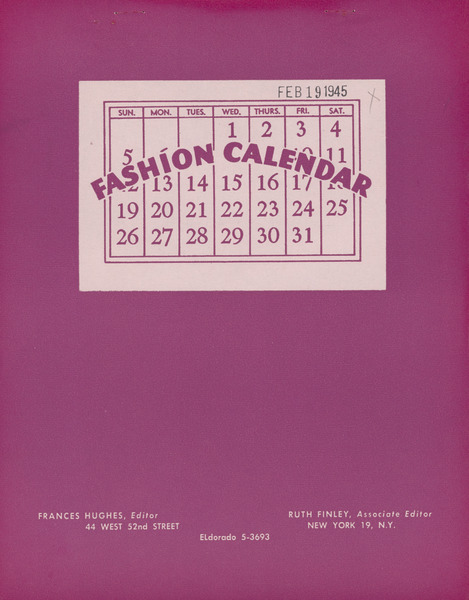 On Saturday, November 11, FIT launched its Fashion Calendar Research Database (FCRD), a digital humanities project and open-source research database that is the culmination of a nearly three-year collaboration among FIT’s History of Art Department, School of Liberal Arts and Sciences, and Special Collections and College Archives of the Gladys Marcus Library.
On Saturday, November 11, FIT launched its Fashion Calendar Research Database (FCRD), a digital humanities project and open-source research database that is the culmination of a nearly three-year collaboration among FIT’s History of Art Department, School of Liberal Arts and Sciences, and Special Collections and College Archives of the Gladys Marcus Library.
The Fashion Calendar was founded by Ruth Finley, who published it from 1941-2014. Originally a biweekly publication, the calendar remains the foremost scheduling and planning tool for fashion designers, press, and retailers connected to the fashion industry. It has long been the premier event resource for fashion, beauty, media, and culture.
Every issue of The Fashion Calendar with its iconic pink pages was donated to FIT, and now the calendar—more than 3,000 issues and upwards of 30,000 pages of material—has been fully scanned and digitized, is searchable and downloadable for free, by anyone wherever they are. The database is the public-facing part of The Ruth Finley Collection: Digitizing 70 Years of the Fashion Calendar, which is supported by a Digitizing Hidden Collections grant from the Council on Library and Information Resources (CLIR). The grant program is made possible by funding from the Mellon Foundation.
The launch of the database was the keynote event of the Archiving Fashion Conference: Mapping Fashion Collections, held at FIT on November 11. The event presented the project’s innovative design and use of AI and machine learning technologies to enhance the text-based archive with digital tools that promote search optimization, data visualization, and mapping capabilities. The conference gathered scholars, researchers, archivists, librarians, faculty, students, and professionals for a one-day event to discuss the present and future of fashion and textiles, and related material, in archives.
In recognition of this seminal event, Newsroom sat down with History of Art faculty member Natalie Nudell, historian and curator of fashion and textiles at FIT, and specialist in the Fashion Calendar and the post-war American fashion industry.

Why was this conference important?
The primary reason was to launch FIT’s Fashion Calendar Research Database (FCRD), the new digital humanities project and open-source research database that is the culmination of an almost three-year collaboration between the History of Art Department, School of Liberal Arts and Sciences, and Special Collections and College Archives of the Gladys Marcus Library.
This was also an international collaboration with external institutions. In June 2022, we presented the FCRD project in progress at the “Archiving Fashion Symposium,” which was hosted by the American University of Paris. During the symposium it became clear that post-Covid fashion and textile collections and the practice of archiving fashion was a topic that interested many scholars, professionals, and students, and there were projects (like ours) that were started during the pandemic and scholars had not had many opportunities to convene and discuss best practices, new interventions, innovations, etc., so there was a real need for this kind of event.
Why are we “archiving fashion”?
Archiving fashion transcends the material objects and includes many other forms of media, texts, textiles, photography, art and more. The goal of the conference was to widen the understanding what it is to archive fashion, and how digital humanities, new approaches to archival practices, and collections management can inform current and future practices.
What is Ruth Finley’s significance to academic study?
Ruth Finley embodied the spirit of the American fashion industry during the 20th century, and her publication of The Fashion Calendar provided a unique and critical service to a national industry. The Fashion Calendar was the independent, centralized schedule of the American fashion and creative industries from 1941 to 2014, when it was acquired by the Council of Fashion Designers of America (CFDA). Finley’s tenure as the arbiter of the American fashion calendar ensured accessibility and representation in the industry. When NYFW was centralized in the 1990s by the CFDA, The Fashion Calendar became the official calendar of fashion week.
Finley herself was a remarkable example of the major impact of Jewish women in the professionalization of the American fashion industry. Her longevity and sustained role over 70 years influenced the development and open nature of the American fashion market.
After Finley’s retirement, she donated her archive to Special Collections and College Archives (SPARC) at FIT. The Ruth Finley Collection’s importance to academic study has led to the development of the FCRD, which will further add to her legacy.
Can you talk a little about the different perspectives that some of the speakers represented?
The speakers represented a diversity of international perspectives and approaches. The conference was both virtual and in-person to open the possibility of exchange with the widest possible reach. We had speakers presenting institutional projects; short-archive presentations; a panel discussion between scholars from four major institutions about the pedagogical value of fashion and textile collections in UK higher education; and digital humanities projects like National Archives of Brazil. FIT was represented in the keynote and in presentations by Dr. Valerie Steele of MFIT and Samantha Levin from Special Collections and College Archives (SPARC).
What kinds of audiences were interested in this conference, and why?
The audience included scholars, archivists, librarians, professionals, students, and some members of the public. A wide variety of audiences were interested in the event likely because it presented new and innovative perspectives on fashion, whether garments or other types of media in collections and archives.
